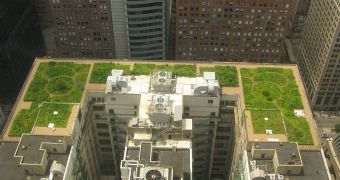Researchers at the US Department of Energy's (DOE) Lawrence Berkeley National Laboratory (Berkeley Lab), in California, argue in a new study that white roofs are the most cost-effective type of roofing available today. The team carried out a comparative analysis of white, black and green roofs.
For this research, scientists considered as green roofs all roofs that contained artificial vegetation, in the form of lawns or small gardens. Black roofs were regular roofs covered in tarmac or other dark-colored materials, while white roofs were sunlight-reflecting roofs painted in white.
The study looked exclusively at the economic costs and benefits associated with each type of roof, and did not consider the environmental implications of any of them. The predictive study assessed the performance of each type of roof over a period of 50 years.
White roofs emerged victorious from this economic competition. What set green roofs back, for example, was their rather high installation costs, as well as the economic requirements they have in terms of maintenance. Their environmental and relaxation benefits could make up for their financial drawback, the team comments.
Details of the investigation appear in a paper entitled Economic Comparison of White, Green, and Black Flat Roofs in the United States, which will be published in the March 2014 volume of Energy and Buildings. The work was authored by Berkeley Lab experts Julian Sproul, Benjamin Mandel, and Arthur Rosenfeld, and Nanyang Technological University of Singapore expert Man Pun Wan.
“White roofs win based on the purely economic factors we included, and black roofs should be phased out,” explains former Commissioner of the California Energy Commission Arthur Rosenfeld, who is also a Distinguished Scientist Emeritus at the Lab.
A total of 22 flat roof projects that were undertaken in the United States were analyzed for this study. For each of these projects, two or more types of roofs were initially proposed. The team carried out a 50-year life cycle cost analysis for each of these roofs.
“We leave open the possibility that other factors may make green roofs more attractive or more beneficial options in certain scenarios. The relative costs and benefits do vary by circumstance,” concludes Mandel, who is a graduate student researcher at Berkeley Lab.

 14 DAY TRIAL //
14 DAY TRIAL //